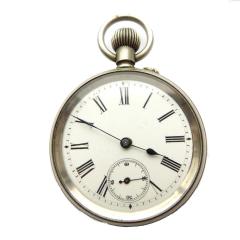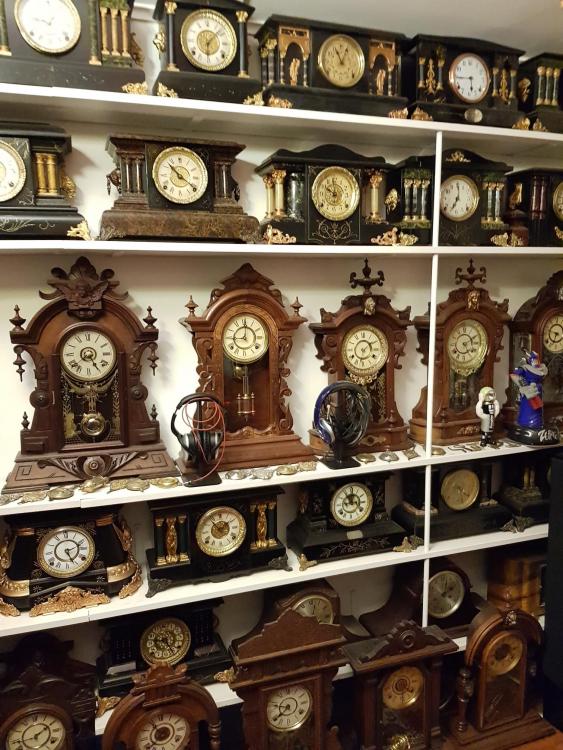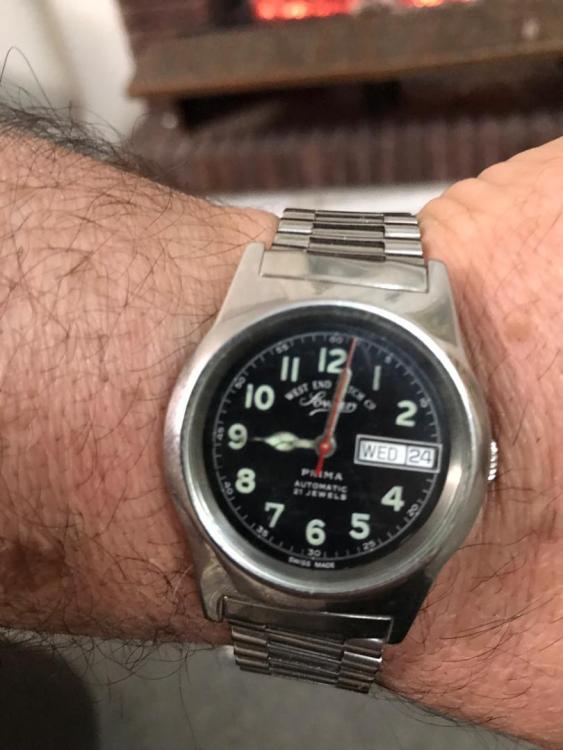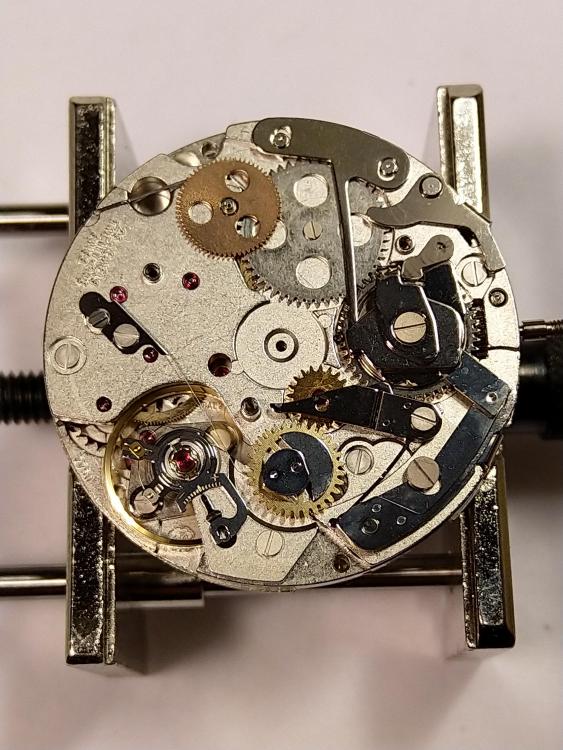Leaderboard
Popular Content
Showing content with the highest reputation on 04/06/19 in all areas
-
Been collecting and restoring antique clocks for over 25 years as a hobby and part time business. Receiving my training from a clockmaker who operated a museum of horology and training in clock repair in South Australia.. After 43 years working full time in a senior government position, I recently retired from the stresses of management to pursue my love of clock repairing and restoration. Over the years I was fortunate to meet and be taught other skills such as French polishing, antique conservation and gold leafing from people who enjoyed sharing their craft. Sadly to say many of these people have passed and like clock repairing are becoming a dying art. Over the years I have I built up a fully tooled workshop and stock piled around 200 unrestored antique clocks to give me plenty to work in my retirement. Some will be added to my collection and others will be sold to fund other purchases. As a long term member of the National Association of Watch And Clock collectors I often read articles relating to watches which fascinated me. i began collecting a few antique pocket watches and often thought about learning watch repair. As my modern wrist watch collection grew, I finally discovered Mark’s You Tube watch repair classes and signed up to his three level courses. So far I have completed the first level course and have just invested in purchasing watch tools. Unfortunately clock repair tools in most cases are not interchangeable with watch tools. I am enjoying the new challenges of watches and hope to apply my learnings to my small and growing collection of mechanical and quartz watches. I look forward to meeting others who share my passion of repairing and collecting timepieces. Photo of a small selection of clocks in my collection I have restored and repaired.2 points
-
My thinking goes along these lines: The name - Ingersoll-Trenton. This must be after the purchase of Trenton by Ingersoll in 1908 The Serial number. I get a range from 1885 to 1908 The case - manufactured in 1908 So the purchase says it can't be before 1908 or it would not have the combined name. The Serial number says it can't be much after 1908 The case was made in 19082 points
-
This is one of the rarest of all rare calibers. Works best compared to other calibers. Take it from me, remove what you can and soak the rest of the movement in kerosene for couple of days, screws would come off like you wouldn,t beleive. Shock springs are easy to remove jewels are easy to clean, all would work like a treat.1 point
-
In theory this should be a drop in replacement, but... 1. Make sure you don’t get confused between shockproof and non shockproof variants... they have different balance staff lengths 2. I have bought supposed balances complete where the terminal curve on the hairspring wasn’t properly formed. However, I would agree this is your best option1 point
-
wow nice job! see iam lazy i would have just replaced the wheel, plus i dont have a lathe so that too1 point
-
Just an FYI, if you look at the Ingersoll serial numbers tables, most of them have in fine print something to the effect that "these tables do not apply to jewelled watches", meaning the Ingersoll Trenton watches. They are usually 7 jewel.1 point
-
Hi This is a france eubauches movement (technotime) there should be a calibre number on the movement for identification purposes. Inside the crown is usually a small neoprene/rubber ring gasket, replacing this along with the case gasket after treating them with silicone grease just a smear and re fitting will improve its its capability to shed water. To remove the stem on these i think it was pull out the stem and a small tag swings out press this tag down and draw out the stem. If you can find the calibre number on the movement it would be a great help.1 point
-
Presumably both the watch owner and repairman reside in europe, perhaps in Great Britton, so I safely conclude the repairman is licenced and knows in and outs of in beat . On the other hand No human being can guarantee a tiny hair didn,t get inside as he screws the back on. No one is perfect , yet limited outlook on a given subjects at an instance. If you were to list all possibilties,fault,issues, you wouldn,t leave any room for me to respond. Thanks to the likes of JJ thompson, Hertz, bose and the rest of great man who showed electrons have spin , EM field exist, and crystals have electrical properties , to give birth to electronics so we can share ideas across the globe and learn, developements, improvements for mankinds betterment stemming from it, are yet to be seen. Aren,t we all learning? Regards1 point
-
West end watch started production like eighty years ago, in calcutta India and mainly targets Asia, where it is a well known and liked brand,last I heard it had sold fifteen million or more pieces. Uses ETA and AS movements. West end watch was the first to adapt incabloc shock protection system. Then again about three hundered pieces found their way to my collection so I learned to like them. Here is piece to start with , don,t run away please.1 point
-
Caliber please, Tudor makes eta movements some beat 28800 bph others higher, this to know and have a baseline to compare readings with. Also the power level at which these TG readings were produced. Was the piece fully wound? half full? One hunderdth? At very low power levels such imperfections are not unexpected especially if the piece is old. Regards1 point
-
I I like your approach for being more suitable especially when the movement is assembled mounted on move- holder and to the TG. Regards1 point
-
yea good idea nuce! force power through the mainspring. best way to do this i would think is fully wind it then push on the ratchet wheel with pegwood and hold it, dont let it seat back into the click. see if amp goes up and then see if it drops when you let it go and ratchet sits back into the click.1 point
-
Needless to say, the slight amout of power to add is what we feel the power source fails to supply. Strongly pushed the escape will lock. I agree with saswatch on both counts, friction and slightly out of beat.1 point
-
John senior has them for £1.75 http://www.obsoletewatchandclockparts.com/Jewels-and-Bushes.htm1 point
-
you have friction somewhere, most likely due to dirt and/or dry pivots/mainspring. this watch needs a full service. new mainspring, cleaning and proper oiling. the watch is still slightly out of beat a little more work and it will be good to go1 point
-
I appreciate very much all the insight. I've done some, and I have a reasonable sense of bearing set ups with AC's - a spindle I designed is below. I did not realize though that the AC for this were the same size - that's an uncommon treat as they usually are not. Provided I can figure out how to accurately measure the outer spacer, I have a surface grinder so can make the inner race spacer to suit the needed preload (or just make it the same). I have not tried to take the outer race spacer out of the headstock - is it removable or is a machined feature of the casting? AC P4's are available everywhere, but deep groove P4's are tougher to find, i.e. SKF or NSK have the former but not the later....so this makes sourcing easier. Now I need you to coach me through bearings for the F1 lol (what a nightmare). Since the theme is home made tools, and we're talking spindles.... here's some photos of a spindle I'm currently working on. Its a new Z carriage and ER spindle for a BCA jib/borer mill. The BCA is a British version of the Boley jig borer/mill. The idea with the T slots is to make it a bit of universal platform for different things, EDM sinker will be the next addition, maybe a slotting head, etc. As the spindle base can tilt, I plan on putting an encoder on the head for an electronic gear hobber as well....so many plans, so little time. I haven't put it together yet, still trying to finish balancing the shaft assembly, which means finishing the homemade dynamic soft bearing balancer1 point
-
1 point
-
New Find Hebdomas. Need some history on it. Runs well. Sent from my iPhone using Tapatalk Pro1 point
-
There are so many aspects of buying a watch that I just had to think through my priorities. 1. OMEGA vintage (a "luxury" Swiss brand, known to most people). 2. Ticking decently. 3. In need of cleaning, crystal polishing (or crystal replacement), a service, and perhaps some minor repair. 4. Looking good enough that I'd be happy to wear it after my overhaul. 5. Being able to sell it (after my overhaul) with a decent prospect of earning a bit on the deal. Although, I so far I haven't been able to sell any of my (I don't know how many) watches (read "children"). So what would be a decent price for this watch in its current condition? The one mentioned in my previous post. I'm not that many years from retirement, and I'm trying to figure out a way to make some extra money on top of my pension by combining benefit with pleasure. I absolutely love "tinkering" with watches. I've built a watch by sourcing parts on eBay for approx. $250, and lots and lots of work on the movement (4 pictures here), but I sort of doubt any or very little profit could be made if I were to try to sell it on eBay. I'm now building another watch (very Paneri like with a California dial, no seconds hand) based on the Unitas 6498. After all, when you can buy a watch looking just as good from China for less than $100, I think the prospects of getting, say near or around $500 or thereabout is very slim.1 point
-
1 point
-
Unfortunately it's not quite that simple as vinn3 As pointed out above. I don't know enough about the watch company in question but a lot of the watch companies sold their movements separate. You'd go to a jewelry store the movements would be in one case the cases would be another case. They did not come together. Not to say that they couldn't come together because often times the watch companies did case their watches up. Then through time watches get swapped in their cases. A lot of times you can tell that if you look where the screws go for holding it in the case they'll be additional marks where others screws were. So what we do get is we know when the case was made. If you can find data that the company purchased their cases from Denison then all of this becomes much much more important. But even though it does give you some dates the case seems about the right time for the watch it's just another clue or breadcrumb to follow on your trail to.1 point
-
there are sites to date the case. the movement should be dated separately. vin1 point
-
This image So that hallmark is Birmingham 1908 https://www.silvermakersmarks.co.uk/Dates/Birmingham/Cycle 1900-1924.html And the makers stamp is as you say Dennison http://www.silvercollection.it/ENGLISHSILVERMARKSXA3.html#862ING So - would it be reasonable to suggest this watch was made on or around the year that Ingersoll bought Trenton - i.e. 1908?1 point
-
In one of the other discussions of this watch you had a link to your Google drive with photographs. What makes the photographs interesting is the case? So I have a link to an article about the case making company. Then the case has marks on it like a British case or in this case a Birmingham case. Then one of the letters is a date code Which dates it is 1908 or 1909. http://www.vintagewatchstraps.com/blogdennison.php1 point
-
Here is what I found on the net: The Trenton Watch Company was a successor to the New Haven Watch Company, which had been started in 1883 in New Haven, Connecticut, but had undergone financial reorganization in 1887. Trenton produced nearly two million watches, most of which were lower to mid-grade pieces in the 7-9-11 jewel range. Most of the watches produced were intended for the domestic market, but factory records indicate that some watches were produced for export to England around the turn of the century. Trenton was subsequently sold to Ingersoll in 1908. Trenton-produced watches were marketed under a variety of brand names, including: Trenton, Ingersoll Trenton, Fortuna, Calumet USA, Advance Watch Co, Marvel Watch Co, Reliance Watch Co, Locomotive Special and Engineers Special. Both the Engineers Special and Locomotive Special were marked as 23-jewel watches, even though they had only 7 functional jewels... the others were fake and were entirely for appearance! Similarly, the watches sold under the Marvel Watch Co. brand-name were marked 23-jewels, even though all but 7 jewels were non-functional. Some of these "fake jewel" watches can be quite collectible today. Trenton also produced two 18-size fly-back chronograph models, both with 9 jewels. Based on a Grade 40 or 41 with chronograph modifications, the watches were produced in limited quantity, and these watches are considered to be quite rare and collectible today.1 point









